Pumpkins are beautiful and useful for humans and animals. When they are fresh and bountiful you can use them after this they can be used by wildlife. They are so satisfying to grow because there is nothing difficult to grow them. They are known as an Emblem of Halloween and it is necessary to know about the pumpkin growing stages.
You can consider them a fun addition to any garden. They require a little space and the plus point is they are not difficult to grow. You need to give them full sun and you should know that larger varieties require space because their vines can grow 20 feet long. You need to learn pumpkin growth stages for the successful experiment of growing them.
Pumpkin Varieties
Pumpkins are available in different sizes and colors as well. This can be difficult to grow a specific variety of pumpkins in your home garden so you should try different varieties to grow. Here are varieties you should learn about:
Fairytale Pumpkin
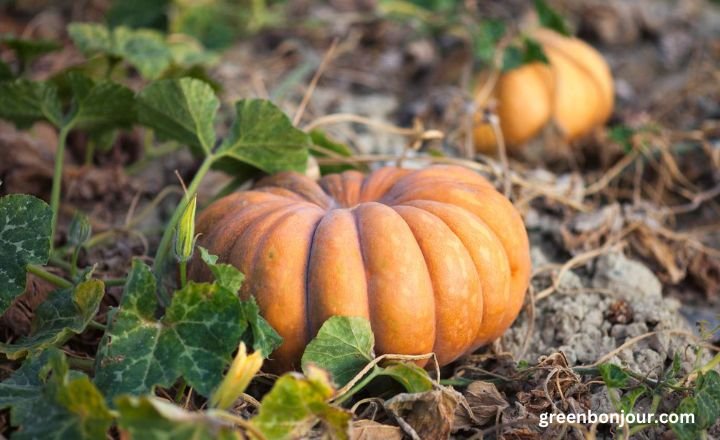
- They have a muted orange color.
- You can see them in a short squatty shape.
- They have deep ridges that offer the pumpkin the classic heirloom pumpkin shape.
- You can roast them, bake them, and can eat them raw as well.
- When they pick the orange color, this is a sign for you to pick them up.
Porcelain Doll Pumpkin
- You will see that they exist in similar shapes as fairytale pumpkins.
- They contain a pink color that makes them different from fairytale pumpkins.
- They also have deep ridges that give a gorgeous effect.
- They are edible and you can eat them by roasting, baking, sautéing, and boiling.
New Moon Pumpkin
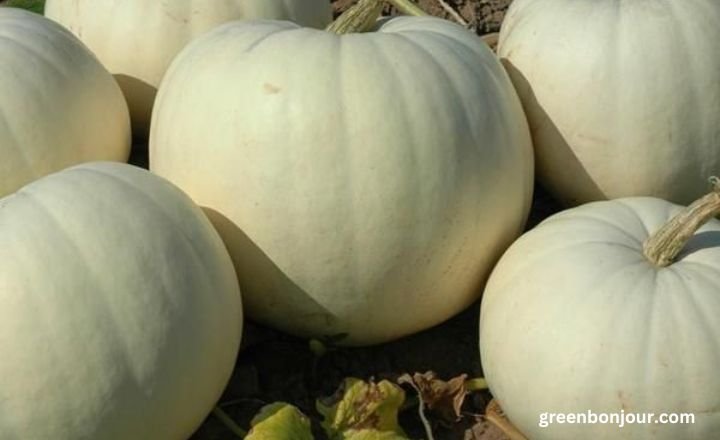
- The amazing fact about this variety is that it has rounded jack-o’lantern-style shapes.
- Their shape makes them stunning and outstanding among all other varieties.
- They exist in an orange color that is bright in appearance.
- They are fast-growing and weigh almost 200 pounds or more.
- They come under easy to carve and you will love the crisp white color of the skin.
- You can use them by baking and then enjoy their tastes.
Mustang PMR Pumpkin
- This variety is known as classic orange Halloween.
- You will be glad to know their scientific name which is Cucurbita pepo (pumpkin).
- Scientists believe that pumpkins originated in North America about 9000 years ago.
- They are also famous for their fall colors.
- You should grow them in medium size because in medium sizes they are considered disease resistant.
- It is recommended that beginner gardeners grow them.
Blue Bayou Pumpkin

- Blue bayou pumpkins are considered to be the sweetest variety of all pumpkins.
- They come in a compact bush variety with blue-grey skin, orange flesh, and fruit to 15cm across.
- You can eat them by cooking and tossing them in pizza.
- You can bake them as well.
- It is a hybrid variety with a heirloom appearance and excellent disease resistance.
Pumpkin Growing Stages
You should know that pumpkins are annual plants, they complete their entire life cycle within a single year. They possess a long growing season, you need to stick with it if you want a proper and enjoyable pumpkin field in your garden.
You can start growing them in the spring and summer seasons. You have to take care of the climate and environment so that they can grow their best. You need to start the process at the correct time as you have to seed the seeds at the correct time. Keep in mind that all winter squash, including pumpkins, must fully ripen on the vine.
Seed Germination
Seed germination is a magical process that sets the stage for life when it comes to the pumpkin stages. This important phase begins when seeds absorb moisture and swell, signaling the start of metabolic activities within.
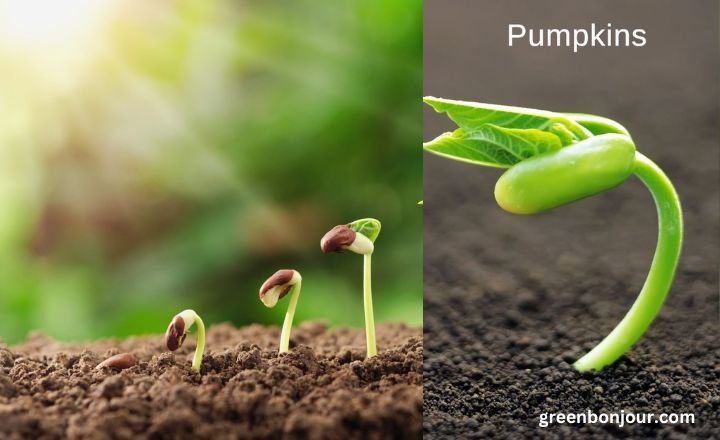
Not all seeds germinate under the same conditions, some require specific temperatures or light exposure to unlock their full potential. The delicate push of the seedling breaking through soil demonstrates nature’s determination in facing adversity; overcoming compact Earth or competing fibers embodies resilience essential for survival.
Seedlings
Seedlings are the delicate beginnings of a plant’s journey, where the potential is packed into every leaf and stem. In the growth stages of a pumpkin plant, these young sprouts take center stage as the foundation for what will soon become sprawling vines.
This early phase is critical; it’s during this tender time that seedlings develop their root systems which is an intricate communication network that nurtures and sustains the entire plant. With proper care, these tiny life forms can absorb nutrients efficiently, setting the stage for vigorous growth later on.
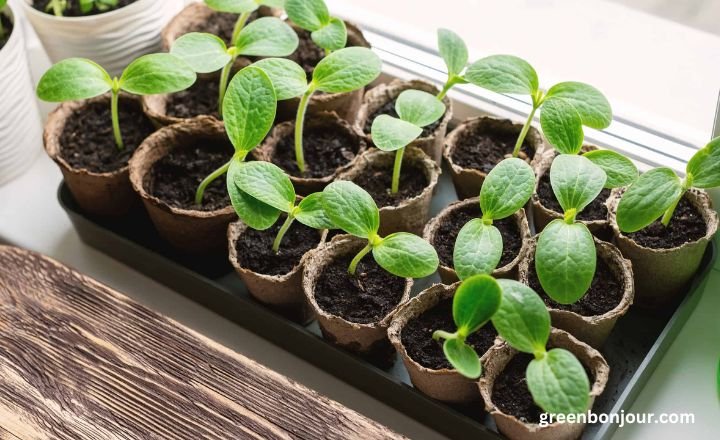
When you talk about the seedlings, this offers gardeners a lesson in patience and nurturing. As they emerge from the soil, it becomes evident how much external conditions such as light and moisture influence their development. This timeline highlights the importance of starting seeds indoors or ensuring optimal planting times outdoors to maximize those sunny days needed for robust growth.
Vegetative Growth
During the vegetative growth stage of a pumpkin plant, the foundation for a robust yield is laid, often overlooked in discussions focused solely on fruiting. This phase is characterized by rapid leaf development, stem elongation, and root expansion.
While many gardeners may eagerly await blossoms and fruits, it’s this early period that dictates future success; healthy foliage significantly enhances photosynthesis, translating into larger pumpkins down the line.
Flowering
In the growth stages of a pumpkin plant, flowering represents a crucial turning point that sets the stage for fruit development. As vibrant yellow blossoms emerge, they’re not just festive additions to the garden; they serve as intricate invitations to pollinators.
Each flower carries secrets about plant health and environmental conditions. Unhealthy plants may produce fewer blooms or miss out on necessary pollination altogether due to stressors like drought or nutrient imbalance.
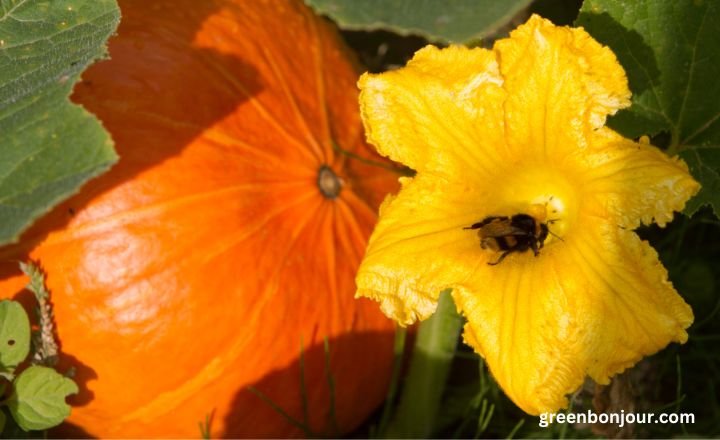
Gardeners can find empowerment in understanding these signs that are adapting care routines based on whether they observe robust flowering or sparse buds can significantly impact overall yield. Embracing these nuances transforms gardening from mere cultivation into a rich tapestry of life cycles where every bloom tells its own story.
Pollination
Pollination plays a pivotal role in the growth stages of a pumpkin plant, transforming isolated flowers into vibrant, life-giving fruits. The journey begins during the flowering stage when the bright yellow blossoms attract various pollinators, such as bees and butterflies.
These insects are not just drawn to the nectar; they also facilitate genetic diversity by transferring pollen between male and female flowers. Interestingly, pumpkins have separate male and female flowers on each vine, promoting a delicate dance of nature where timing is essential for successful fertilization.
Understanding this process opens a window into the interdependence of ecosystems. Factors like climate change and declining bee populations directly influence pollination rates, which in turn affect pumpkin yield and quality. Home gardeners can enhance this vital process by planting companion plants that attract pollinators or by hand-pollinating their crops during peak growth phases.
Early Fruiting
Early fruiting in pumpkin plants is a marvel of nature that highlights the intricate balance between environmental conditions and plant physiology. As these vibrant vines begin their growth stages, they transition from leafy green shoots to producing those iconic, round fruits faster than many gardeners anticipate.
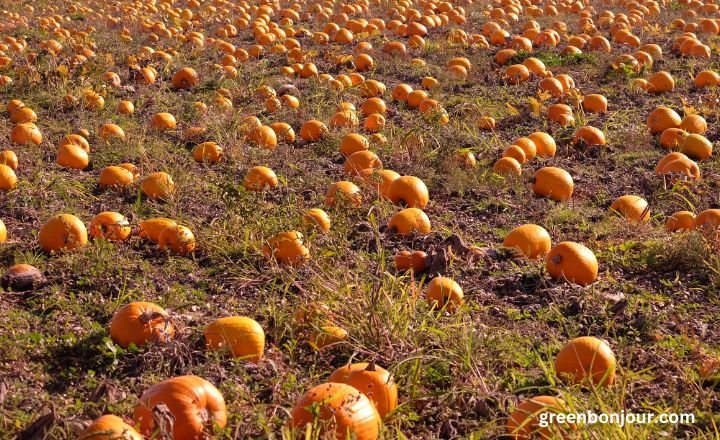
Factors such as temperature, soil quality, and water availability play crucial roles in this process. Warmer soils can accelerate germination, while optimal nutrient levels facilitate the quick development of blossoms into mature pumpkins.
Fruit Development and pumpkin ripening stages
Fruit development and ripening are fascinating processes that reveal the intricate relationships between plants and their environments. During the growth stages of a pumpkin plant, the transition from flowering to fruiting is heavily influenced by factors like temperature, moisture, and nutrient availability.
Once fertilized, the pumpkin undergoes stunning changes as it grows from a tiny ovary into a large fruit. Ethylene production ramps up during ripening, signaling physiological changes within the fruit that affect color, texture, and taste.
Understanding these stages not only deepens our appreciation for pumpkins but can also inspire sustainable agricultural practices aimed at optimizing crop quality through careful management of environmental conditions.
Harvesting & Storing Pumpkins
It’s time to turn our attention to the rewarding task of harvesting pumpkins. Understanding the growth stages of pumpkin plants can greatly enhance your harvesting experience. Pumpkins are ready for harvest when their skin is firm and their color is fully developed.
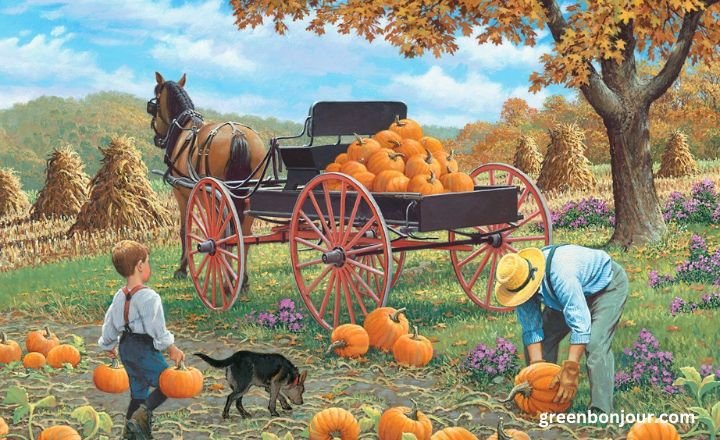
Once you’ve carefully harvested your pumpkins, proper storage techniques are key to prolonging their shelf life and brilliance. Aim for a cool, dry place with good ventilation; a temperature between 50-60°F is ideal. Make sure they’re placed on straw or wood pallets rather than directly on concrete surfaces which can promote rot from moisture buildup.
How far apart need to plant pumpkins?
When planting pumpkins, you have to understand their growth stages which are crucial to determining the optimal spacing. You should plant pumpkin seeds or seedlings at least 3 to 5 feet apart to allow for robust root development and sprawling vines.
Seasoned gardeners often find that grouping your plants can also optimize light exposure and create a visually striking landscape. For example, interspersing taller crops like corn can provide shade, which can be a strategic advantage during hotter months while still giving pumpkins the room they need to thrive.
You need to take care of the soil quality and moisture retention in your garden; well-drained dirt encourages deeper rooting that can further enhance fruit size if spacing is thoughtfully considered throughout the growth stages. Clever planning not only maximizes space but also celebrates these dynamic growers as part of a harmonious garden ecosystem.
| Pumpkin Vine-Growth Category | Spacing Between Plants(within a row) | Spacing Between Rows |
| Bush | 2-3 feet apart | 5-6 feet apart |
| Semi-vine | 2-4 feet apart | 6-8 feet apart |
| Vine | 4-5 feet apart | 8-10 feet apart |
Conclusion
The stages of pumpkin growth is a fascinating journey that encompasses several distinct stages, from seed germination to maturity. Each phase plays a crucial role in developing the vibrant and robust fruit we associate with fall festivities.
Understanding pumpkin growing stages not only enhances our appreciation for this beloved gourd but also equips us with the knowledge needed for successful cultivation. Whether you’re a seasoned gardener or a novice, observing the transformation of pumpkins can be a rewarding experience. So, gather your seeds and start your own pumpkin patch; witness firsthand the magic of nature’s cycle.
FAQs
How many pumpkin seeds per hole?
Wherever you choose to start them, it’s best to sow two seeds per hole and thin the weakest plant out later on. And if you choose to direct sow outdoors, start your pumpkins off under cloches to give them the best start.
What soil do pumpkins grow best in?
Pumpkins and squash can be grown successfully on almost any good soil where they will receive full sunlight throughout the day. Sandy soils high in organic matter are best because the soul will warm up fast and drain quickly. If the soil is heavy (clay), it might help to add sand and organic matter.